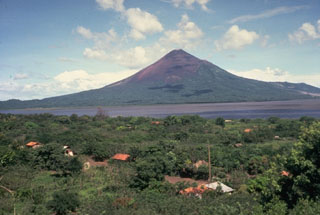Report on Momotombo (Nicaragua) — December 2000
Bulletin of the Global Volcanism Network, vol. 25, no. 12 (December 2000)
Managing Editor: Richard Wunderman.
Momotombo (Nicaragua) Previously unreported low activity during March and April 2000
Please cite this report as:
Global Volcanism Program, 2000. Report on Momotombo (Nicaragua) (Wunderman, R., ed.). Bulletin of the Global Volcanism Network, 25:12. Smithsonian Institution. https://doi.org/10.5479/si.GVP.BGVN200012-344090
Momotombo
Nicaragua
12.423°N, 86.539°W; summit elev. 1270 m
All times are local (unless otherwise noted)
This report discusses previously unreported information about the activity during March and April 2000. This interval of low activity occurred prior to one with heightened seismicity during May and June 2000 (BGVN 25:06).
The seismic swarm that began in May 2000 reached its peak during 9-11 June when the INETER seismic network registered over 500 earthquakes (BGVN 25:06). Many of the earthquake magnitudes were between 3.4 and 4.1, and the small epicentral area was directly under a geothermal plant on the S slope of the volcano. INETER reported that prior to the seismic activity, in March 2000, seismicity was low, with only two seismic events during the month. They did not visit the volcano during March.
On 9 April, Pierre Delmelle of the Université de Montréal along with local guides visited the volcano's crater. According to Delmelle, the crater was horseshoe-shaped and recent landslides had occurred down the crater's walls. He also noted that the majority of the fumarolic activity took place in the bottom of the crater. Gas was released from the fumaroles with very weak pressure, and temperatures ranged from 100 to 460°C. INETER personnel made a previous trip to the crater interior in September 1998 and found a lack of fresh landslides down the crater walls; fumarolic gas temperatures were 79 to 235°C.
Geological Summary. Momotombo is a young stratovolcano that rises prominently above the NW shore of Lake Managua, forming one of Nicaragua's most familiar landmarks. Momotombo began growing about 4500 years ago at the SE end of the Marrabios Range and consists of a somma from an older edifice that is surmounted by a symmetrical younger cone with a 150 x 250 m wide summit crater. Young lava flows extend down the NW flank into the 4-km-wide Monte Galán caldera. The youthful cone of Momotombito forms an island offshore in Lake Managua. Momotombo has a long record of Strombolian eruptions, punctuated by occasional stronger explosive activity. The latest eruption, in 1905, produced a lava flow that traveled from the summit to the lower NE base. A small black plume was seen above the crater after a 10 April 1996 earthquake, but later observations noted no significant changes in the crater. A major geothermal field is located on the south flank.
Information Contacts: Wilfried Strauch and Virginia Tenorio, Dirección General de Geofísica, Instituto Nicaragüense de Estudios Territoriales (INETER), Apartado 1761, Managua, Nicaragua (URL: http://www.ineter.gob.ni/); Pierre Delmelle, Département de Géologie, Université de Montréal, Montréal, Québec H3C 3J7, Canada.

